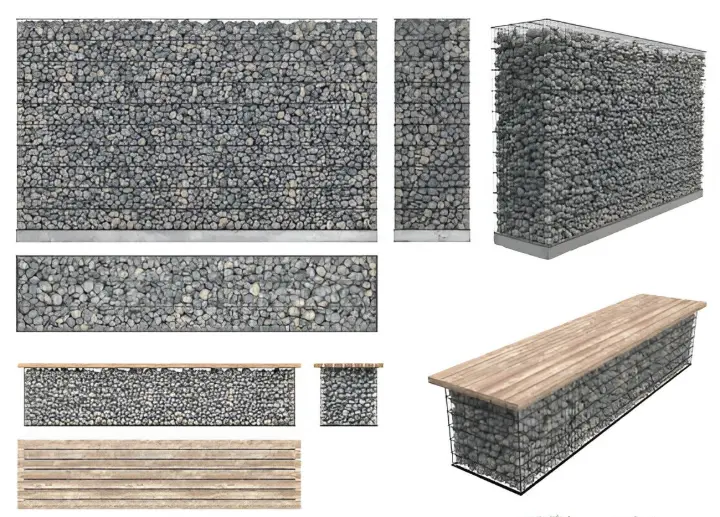Retaining wall is required structure that is designed in landscaping and construction practice having the objective of holding back soil, inhibiting erosion and forming flat, usable terrain of sloping ground. The type of retaining wall is key whether you are constructing a driveway terrace or reinforcing a garden terrace. It all matters in terms of strength, durability or even appearance.

Types of Retaining Walls
Gravity retaining wall
How it works: It is dependent on the weight of itself in order to keep the pressure of the soil behind it.
- Building materials: Stone, concrete or gabion baskets.
- Most suitable: Short walls (less than 4 feet) that drain well.
- Advantage: Easy to construct with less reinforcements.
Cantilever Retaining Wall
Function: It is made of a reinforced concrete base that gets leverage to contain soil.
- Type of materials: Reinforced concrete (steel bars).
- Best match: Taller walls which are under high pressure.
- Advantage: durable, space-economical, with a higher building cost.
Sheet pile retaining wall
- Operation type: Sheets of narrow steel, vinyl or wood, driven into the ground deeply.
- Materials: steel or plastic sheet piles.
- Suitable: Smallish places or where there is loose soil.
- Advantage: Fast in installing yet small in height capacity.
Anchored retaining wall
How it works: Made up of cables or anchors which are driven deep into the soil behind the wall to extra support.
- Working materials: any type of wall and metal anchors.
- Suitable when: Loads are heavy or walls are tall.
- Benefit: Best choice; suited where space is small but loads big.
Gabion retaining wall
- The mechanics: Stony wire-mesh cages, balanced to form structures and support.
- Elements of used materials: Galvanized steel baskets and rocks.
- Suits: Under nature, wetlands, and stream banks.
- Advantage: Ecologically sound, previous, durable and fashionable.
Pro Tip: In case you desire both strength and the appearance that is not artificial, the gabion retaining walls offered by Hitech Gabion are what you should go for, especially in the harsh environment of Saudi Arabia.
How to Build a Block Retaining Wall (Step-by-Step)
Building a block retaining wall can be a DIY project for homeowners if the height is under 3 to 4 feet. Here’s a simple guide:
Step 1: Plan & Measure
- Determine wall location and length
- Check local building codes for height limits
- Mark the layout using stakes and string
Step 2: Excavate the Base
- Dig a trench 4–6 inches deeper than the block height
- Make the trench wide enough for the block + 6 inches on each side
- Add and compact a gravel base (4–6 inches deep)
Step 3: Lay the First Row
- Use a level and rubber mallet to ensure the first row is perfectly flat
- This row is the most important—accuracy here ensures wall stability
Step 4: Stack the Wall Blocks
- Stagger blocks like bricks for strength
- Use landscape adhesive or interlocking features
- Backfill with gravel behind each row to promote drainage
Step 5: Add Drainage
- Install a perforated drain pipe at the base if the wall is over 2 feet
- Cover with gravel and landscape fabric to prevent clogging
Step 6: Cap the Wall
- Apply adhesive to the final row
- Lay capstones for a finished look
Step 7: Final Backfill and Finish
- Backfill the remaining area with soil or decorative stones
- Compact lightly and landscape as desired
Why Use Hitech Gabion for Your Retaining Wall?
| Feature | Hitech Gabion Advantage |
|---|---|
| Locally manufactured | Designed for the Saudi climate and soil conditions |
| Environmentally friendly | Uses recycled stone and steel mesh |
| Customizable design | Flexible dimensions and modern aesthetics |
| Long lifespan | Rust-resistant and weatherproof |
| Professional support | Expert advice and engineering assistance available |
Final Thoughts
Whatever you create: a small garden retaining wall or a huge item in the landscaping facility, knowing what the retaining walls are and how to perform the building of the brick retaining wall can be the key to transforming your place right now and without a doubt. And to achieve trendy, eco-friendly and robust solutions, all that you require to construct it right the first time is available to you at Hitech Gabion.
Frequently Asked Questions
A retaining wall is a structure built to withstand lateral soil pressure and hold soil back on lower ground. It is widely used in landscaping, construction, and road development to prevent erosion and make sloped land usable.
Gravity retaining walls or gabion retaining walls are ideal for residential areas. They are cost-effective, durable, and aesthetically pleasing, especially when stone or gabion baskets are used for a natural look.
Yes. Many online tools and websites allow you to create a virtual retaining wall, customize height, materials, drainage, and view 3D layouts before construction.
Large retaining wall blocks are ideal for high walls, driveways, and steep slopes needing maximum strength and stability. Made of concrete, they often have interlocking features for added structural integrity.
Yes. A solid foundation is essential, often a trench with compacted gravel for drainage and stability. Taller walls may require a reinforced concrete footing.
Natural stones like granite, limestone, or fieldstone are durable and visually appealing. Gabion baskets filled with stone offer an eco-friendly alternative.